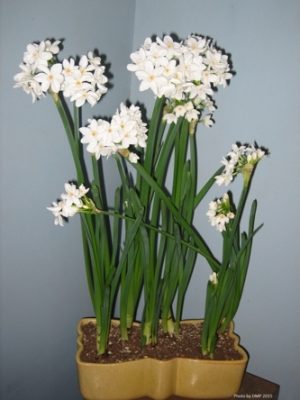
Paperwhite narcissus have been cherished by indoor gardeners for over two hundred years. Then as now, the easily forced bulbs were potted up and coaxed to reveal their gorgeous blooms that fill the air with their exotic fragrance. Part of the charm of growing paperwhites lies in their ease of cultivation. Children find their rapid rate of growth captivating, beginning gardeners are encouraged by their success, and the more experienced appreciate their heady scent and decorative appeal. Their common name, paperwhites, comes from the papery feeling of the petals as the flowers age.
Select firm, large bulbs. Double-nosed bulbs, which are those that have a smaller offset attached will often produce an extra stem of flowers. For holiday gifts, pot bulbs up now. Those not used immediately can be stored in a cool but not freezing location. Keep their exposure to bright light to a minimum to discourage growth from starting before you want it to.
While paperwhites can be grown in almost any container, they look most attractive in short, wide bowls. Many handsomely designed clay or ceramic ones are available. Your container should be a minimum of 2 ½ to 3" high as roots may push the bulbs out of more shallow selections. If you are just planning to grow paperwhites in water, make sure to find an attractive container without drainage holes. Do keep in mind that water in ceramic or clay containers can wick through porous, unglazed bottoms so keep a waterproof pad underneath to prevent any staining of furniture.
Planting the bulbs in potting media helps to stabilize the often-top-heavy plants. The potting media does not have to have any additional fertilizer added to it as all the nutrients and energy necessary for leaf growth and bloom is contained in the bulb. Use conventional potting soil in pots with drainage holes or decorative marble chips or small stones in those without. Grow paperwhites in the same soilless potting mix used for all other houseplants.
 Whichever medium you choose, fill the pot or container about halfway. Then position the bulbs so that they are close but not touching. Fill in around the bulbs leaving the top quarter or so exposed. Water those planted in potting mix thoroughly and allow the container to drain. For bulbs set in decorative chips or stones, the water level should be kept just at the bottom of the bulbs. If the water covers the bulbs, they will rot.
Whichever medium you choose, fill the pot or container about halfway. Then position the bulbs so that they are close but not touching. Fill in around the bulbs leaving the top quarter or so exposed. Water those planted in potting mix thoroughly and allow the container to drain. For bulbs set in decorative chips or stones, the water level should be kept just at the bottom of the bulbs. If the water covers the bulbs, they will rot.

Place the potted bulbs in a dark, cool place until the roots form or place the container on a sunny but cool windowsill. Check the moisture level regularly and every day or two, give the container a quarter turn so the leaves will not lean towards the light.
Leaves will quickly start to grow and flower buds appear in about 3 weeks. They begin to open about 2 weeks later so plan accordingly when presenting paperwhites as gifts. You can speed up or slow down the growth process slightly by regulating the temperature. Warmer temperatures encourage faster growth while cooler temperatures slow it down.
Too high temperatures and/or low light levels can cause paperwhites to grow leggy and flop over. Try to keep the temperature around 60° F. These plants are happy on cool windowsills. Floppy plants can be tied up with green yarn or if too leggy, just use the blossoms as cut flowers.
Usually only one variety of paperwhite narcissus is offered at most local garden centers but several cultivars are available through mail order sources and they vary in height and intensity of their fragrance. ‘Soleil d’Or’ is a golden yellow with a softer scent than many paperwhites. Whether looking for a gift for a friend or even yourself, think about a bowl of paperwhites. Although not hardy here, these beautiful expendables may create just the holiday cheer you’ve been looking for.
Despite good cultural practices, pests and diseases at times may appear. Chemical control should be used only after all other methods have failed.
For pesticide information or other questions please call toll free: 877-486-6271.
UConn Home and Garden Education Center, 2018